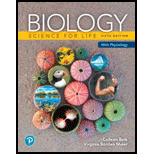
Concept explainers
Is a round yellow pea seed (genotype Rr Y y) an example of polygenic inheritance? Why or why not?
To write:
Whether a yellow colored pea with round shape is an example of polygenic inheritance.
Introduction:
The inheritance in which a polygenic trait is inherited by an organism is called polygenic inheritance. The polygenic trait is a type of trait in which two or more genes control a particular trait. The polygenic traits are different from normal traits as they have multiple genes controlling a particular trait.
Explanation of Solution
The round pea seed with yellow color (genotype RrYy) contains two genes for color and shape. One gene codes for the color and the other codes for the shape. There is no gene that codes for both shape as well as the color. The genes separate during cell division. This is called independent assortment. The gene coding for color separates from the gene coding by the process of independent assortment. This indicates that a pea plant with genotype “RrYy” is not an example of polygenic inheritance.
Therefore, a yellow and round pea seed with genotype “RrYy” is not an example of a polygenic trait. This is because both traits are controlled by different genes and not by a single gene.
Want to see more full solutions like this?
Chapter 9 Solutions
Biology: Science for Life with Physiology (6th Edition) (Belk, Border & Maier, The Biology: Science for Life Series, 5th Edition)
- Which of the 6 modes is this pedigree and why? 1) Autosomal Dominant 2) Autosomal Recessive 3) X-linked Recessive 4) X - linked Dominant 5) Y-Linked 6) mt-Linkedarrow_forwardIn this case a family history revealed a genetic basis for the disorder. The pedigree is shown in Fig. 1 Below. Key Ø Female: affected Female: unaffected || IV V 5600 orize 077808 15 10 9 10 CHO વ Male: affected Male: unaffected Deceased Disease status not given Dizygotic twins Monozygotic twins Fig. 1 Disease pedigree. Five generations I, II, III, IV, V are shown. Females are represented by circles, males by squares, dizygotic (non-identical) twins by diagonal lines originating from the same point, Monozygotic (identical) twins by diagonal lines originating from the same point and joined symbols and deceased by a diagonal line through the symbol. Filled symbols indicate that the individual displays the disease phenotype. Unfilled symbols indicate that the individual does not display the disease phenotype. Carriers of the disease are not indicated. Information on disease status is not known for generation I and is omitted for the individuals represented by a symbol with an asterisk.…arrow_forwardFor the following problems, please choose from the following modes of inheritance: autosomal dominant, autosomal recessive, X-linked dominant, X-linked recessive 8080 50 OTO ㅁㅇㅇㅁ I. What is the most likely mode of inheritance portrayed in the pedigree above?arrow_forward
- In a multigenerational study of a family, 8% of the males and 8% of the females have red hair. What may be the cause of this? A)Autosomal inheritance B)Environmental influence C)Sex-linked inheritance D)Non-somatic inheritancearrow_forwardWhat is the most likely pattern of inheritance for this disorder? (Is it autosomal dominant? Autosomal recessive? X-linked dominant? X-linked recessive? Y-linked? Mitochondrial?) Please include two specific pieces of evidence, present within the pedigree, that indicate that this pattern is most likely, as opposed to any other potential pattern. You may assume that the gene responsible for the trait is fully penetrant.arrow_forwardWhat is the inheritance pattern using punnet square ? Given that: P²: WwSs × WwSs Where: W-purple ww-white S-smooth ss-wrinkledarrow_forward
- in this image How many different phenotypic categories do you observe in the resulting progeny? Which phenotype(s) is/are different between these categories?arrow_forwarda) b) X³ Xb X²Y A Figure 1 Name the pattern of inheritance in figure 1. Briefly explain the consequence of this inheritance to the third son labeled A.arrow_forwardIn Drosophila, the white gene located on the X chromosome affects eye color; an autosomal gene, wingless, is on an autosomal chromosome. Use the following allele symbols: Xw+ _ , Xw+Y = wild type red eyes; X-linked dominant allele Xw Xw , XwY = white eyes; X-linked recessive allele Y = Y sex chromosome vg+ = wild type wings; autosomal dominant vg = wingless; autosomal recessive Predict ratios/proportions of genotypes and phenotypes of offspring from the following cross, of a white-eyed male with wild type wings and a wild type red eyed female with wild type wings: indicate sex of offspring along with phenotypes. XwY vg+ vg x Xw+Xw vg+vgarrow_forward
- This is a typical pedigree for a family that carries neurofibromatosis. Is individual I-2 most likely homozygous or heterozygous? Why? Explain.arrow_forwardMany genetic disorders exhibit locus heterogeneity. Define andgive two examples of locus heterogeneity. How does locus heterogeneityconfound a pedigree analysis?arrow_forwardWhy do unrelated children with a disorder such as Down syndrome resemble each other more closely than they do their siblings?arrow_forward
 Concepts of BiologyBiologyISBN:9781938168116Author:Samantha Fowler, Rebecca Roush, James WisePublisher:OpenStax College
Concepts of BiologyBiologyISBN:9781938168116Author:Samantha Fowler, Rebecca Roush, James WisePublisher:OpenStax College Biology (MindTap Course List)BiologyISBN:9781337392938Author:Eldra Solomon, Charles Martin, Diana W. Martin, Linda R. BergPublisher:Cengage Learning
Biology (MindTap Course List)BiologyISBN:9781337392938Author:Eldra Solomon, Charles Martin, Diana W. Martin, Linda R. BergPublisher:Cengage Learning Biology: The Unity and Diversity of Life (MindTap...BiologyISBN:9781305073951Author:Cecie Starr, Ralph Taggart, Christine Evers, Lisa StarrPublisher:Cengage Learning
Biology: The Unity and Diversity of Life (MindTap...BiologyISBN:9781305073951Author:Cecie Starr, Ralph Taggart, Christine Evers, Lisa StarrPublisher:Cengage Learning Human Heredity: Principles and Issues (MindTap Co...BiologyISBN:9781305251052Author:Michael CummingsPublisher:Cengage Learning
Human Heredity: Principles and Issues (MindTap Co...BiologyISBN:9781305251052Author:Michael CummingsPublisher:Cengage Learning
 Human Biology (MindTap Course List)BiologyISBN:9781305112100Author:Cecie Starr, Beverly McMillanPublisher:Cengage Learning
Human Biology (MindTap Course List)BiologyISBN:9781305112100Author:Cecie Starr, Beverly McMillanPublisher:Cengage Learning





